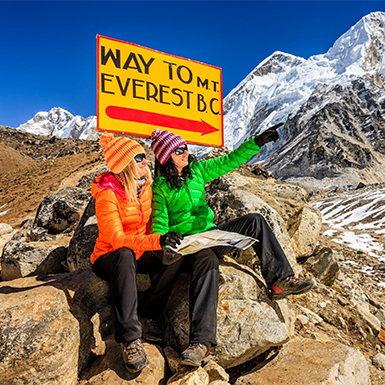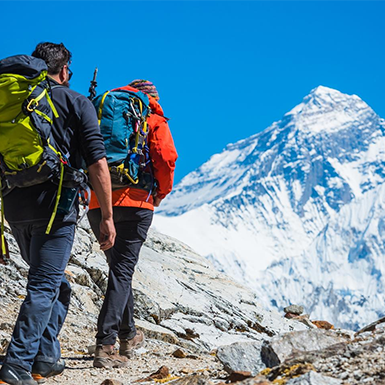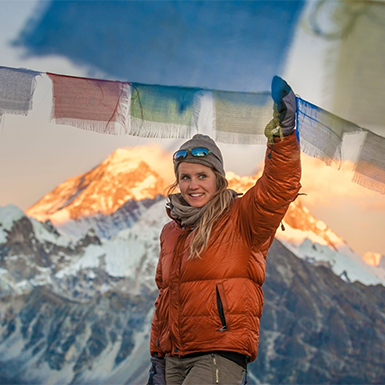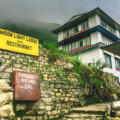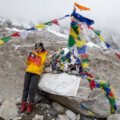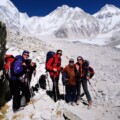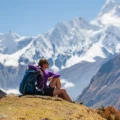Setting out on a journey to Everest Base Camp is both an adventure and a rigorous test of endurance and preparation. Aspiring trekkers must meticulously plan and train to fully grasp how to prepare for Everest Base Camp, addressing every aspect, from physical conditioning to detailed logistical arrangements. Specialized fitness routines designed to boost endurance and cardiovascular strength are crucial for handling the trek’s demanding challenges. Additionally, choosing the right gear is vital—layers suitable for extreme weather, sturdy trekking poles for support, and reliable navigation tools like headlamps are essential. Preparation also includes health considerations, where proper acclimatization strategies are key to preventing altitude sickness, and effective hydration techniques are necessary to manage dry and cold conditions.
How to train for Everest
How to train for Everest involves selecting the optimal time of year for the trek to take advantage of favorable weather, securing experienced local guides and porters who enhance the safety and depth of the trekking experience, and ensuring access to essential resources such as clean and warm water. Protecting oneself from intense UV radiation with high SPF sunscreen and quality sunglasses, managing personal hygiene with biodegradable wipes in the absence of regular bathing facilities, and embracing local culture through enjoying traditional Nepalese snacks all contribute to the overall experience. These measures not only protect the health and safety of trekkers but also enhance their ability to enjoy and appreciate the spectacular vistas and the profound sense of achievement. This comprehensive approach allows participants to thrive throughout this once-in-a-lifetime expedition to Everest Base Camp.
1. Pack Smart
Your backpack and duffle bag are essential tools on the trek to Everest Base Camp. Packing smartly is crucial to manage the load and ensure you carry all necessary items without overburdening yourself. Start by listing all essential items based on the duration of your trek and expected weather conditions. Balance the weight evenly and make use of every space efficiently, using packing cubes or bags to organize items by category (clothing, first aid, electronics). Remember, the key is to travel light but well-equipped, focusing on multipurpose gear and clothing that can handle temperature variations and rugged terrain.
2. Hydration is Key
Hydration must be balanced when trekking to high altitudes like Everest Base Camp. Dry air and exertion can lead to quick dehydration. Carry 2-4 liters of water daily, using a hydration bladder with a tube for easy access, allowing you to drink without stopping frequently. This setup is essential for maintaining a steady pace. Incorporate electrolytes into your water to replace salts lost through sweat and to boost your energy levels. Plan your water sources, whether it’s refilling at teahouses or using water purification tablets, to ensure safe and sufficient hydration throughout the journey.
3. Rain Protection
The weather in the Himalayas can be unpredictable, with sudden rainfall even during the dry season. Effective rain protection starts with a reliable raincoat or poncho that covers you and your backpack. Additionally, equip your pack with a rain cover and invest in gaiters that will help keep your feet dry and prevent mud from getting into your boots. These items are not only about comfort but are essential for preventing hypothermia and keeping morale high in wet conditions. Consider waterproof bags inside your backpack for sensitive items like electronics and documents.
4. Trekking Poles
Trekking poles are more than an accessory; they are a critical tool for maintaining stability and reducing the impact on your legs, hips, and knees, especially when carrying a heavy pack. Choose poles that are sturdy yet lightweight, with shock absorption features and comfortable grips. Learn to adjust the poles according to the terrain; shorter for uphill climbs and longer for downhill. Training with poles before your trek can also help you get used to the additional equipment, ensuring you’re efficient and prepared for the long walks ahead.
Each of these points delves into the essential aspects of preparation for the Everest Base Camp trek. The better you prepare, the more you can focus on enjoying the breathtaking views and unique experiences of your Himalayan adventure.

5. Layer Your Socks
Proper foot care is critical on the Everest Base Camp trek. To avoid blisters and maintain warmth in your feet, it’s advisable to wear two layers of socks. Start with a thin nylon sock that sits close to your skin, managing moisture and reducing friction. Over this, wear a thicker, woolen sock to provide insulation. This combination ensures both comfort and protection against the cold. Test your sock setup on long training walks to ensure there’s no bunching or slipping, which can lead to blisters over time.
6. Dress in Layers
The key to handling the mountain’s varying temperatures is layering. Begin with a moisture-wicking base layer that keeps sweat away from your skin. Add a breathable, long-sleeve T-shirt as your middle layer, followed by a warm hoody for insulation. Top these with a windproof and waterproof jacket to shield against the elements. This layering strategy lets you adapt to varying weather conditions by easily adding or removing layers as required. Always remember that the goal is to stay warm without overheating or sweating excessively, as this can lead to discomfort and cold.
7. Energy Snacks
Maintaining high energy levels is essential during the strenuous days of hiking. Pack lightweight, high-energy snacks that you can eat on the move. Options like granola bars, trail mix, nuts, and dried fruits are excellent as they provide quick calories and are easy to digest. Plan your snack consumption for every couple of hours to maintain energy levels, and consider your body’s response to high-altitude digestion, which can be slower and more sensitive.
8. Face and Neck Protection
Protecting your face and neck from the harsh elements is vital. A high-quality face and neck gaiter can guard against the cold wind, dust, and sun exposure, all of which you’ll encounter on the trek. Choose a gaiter that is made from lightweight, breathable fabric with moisture-wicking properties to ensure comfort. Wearing it can also help warm the air you breathe, which is particularly beneficial in cold conditions and can reduce respiratory distress.
9. Nasal Decongestants
At high altitudes, the air is not only thinner but also drier, which can lead to nasal congestion. This condition can make breathing even more challenging and uncomfortable. To mitigate these effects, it’s advisable to pack a saline nasal spray and a decongestant such as Otrivin. These items will help maintain nasal moisture and open up nasal passages, ensuring easier breathing. Begin using these sprays a few days before reaching higher elevations to acclimate your body and reduce the likelihood of discomfort.
10. Light Your Way
Visibility is crucial in any trek, particularly when navigating the challenging terrains of Everest Base Camp during dawn, dusk, or night times. A reliable headlamp is a crucial item of equipment for these situations. Opt for a headlamp that provides a strong, wide beam and includes a comfortable, adjustable head strap. Ensure it has a long battery life, or carry extra batteries as necessary. Consider the benefits of LED lamps for their durability and efficiency, and test the headlamp in different conditions before your trek to ensure it meets your needs.
11. Power Supplies
In today’s digital age, keeping electronic devices charged can be as crucial as any other aspect of trek preparation, especially for safety, communication, and navigation tools like GPS. Carry a durable, heavy-duty battery charger, and consider a solar charger if you expect sunny conditions. These devices will help keep your smartphones, cameras, and other electronic devices powered throughout your journey. Check the compatibility of your chargers with your devices and ensure they are robust enough to handle cold and possibly damp conditions.
12. Guidance and Assistance
The value of having experienced professionals during your trek cannot be overstated. Employing an experienced guide and a porter can greatly improve your trekking experience. A guide not only helps in navigating the trails but also provides insights into the local culture, flora, and fauna. Additionally, a porter can manage the heavy lifting of your gear, which allows you to conserve energy and enjoy the scenery more fully. Ensure that your guide and porter are adequately equipped and compensated, as their expertise and well-being are crucial to the success of your trek.
13. Sun Protection
The strength of the sun at high altitudes often catches many trekkers off guard. Effective sun protection is crucial to prevent sunburns and UV damage, especially when the sun reflects off snow. For optimal sun protection during your Everest Base Camp trek, choose a broad-spectrum sunscreen with SPF 50 or higher. Apply it generously to all exposed skin, ensuring no areas are missed. Before hitting the Everest Base Camp trail, liberally apply sunscreen with SPF 50+ to all exposed skin.
Remember, sweat and swimming necessitate reapplication throughout the day for optimal protection. Reapply it every two hours or more often if you are sweating a lot. Include a lip balm with sun protection to prevent chapped lips, and wear UV-protected sunglasses to save your eyes from harmful rays and glare. Choosing sunglasses that offer side protection can also help prevent snow blindness, a painful but preventable condition.
14. Head and Ear Cover
Temperatures at high elevations can plummet, making adequate headwear essential. A monkey cap or a balaclava provides comprehensive protection against cold winds and freezing temperatures, covering your head, ears, and often your neck. This type of headgear is invaluable for preventing heat loss and protecting sensitive areas, such as the ears, which are vulnerable to frostbite. Select a head cover made from materials that retain warmth even when wet and that can fit comfortably under a helmet or hood.
15. Stay Warm with Drinks
Keeping warm internally is just as important as external protection. Consuming warm beverages such as ginger tea and lemon tea throughout the day can play a crucial role in maintaining body temperature and hydration. These drinks also have the added benefits of soothing the throat, calming the stomach, and providing a comforting psychological boost. Ginger, in particular, is known for its anti-nausea properties, which can help combat symptoms of altitude sickness.
16. Ginger for Health
Carrying and consuming slices of ginger can provide significant health benefits during your trek. Ginger has natural properties that help fight inflammation, reduce nausea, and clear nasal passages, making it an ideal companion for high-altitude trekking. You can chew on raw slices or add them to your tea. Not only does it help with altitude sickness, but it also boosts your immune system, which is crucial in the harsh and demanding environment of Everest Base Camp.
17. Warm Water Access
Understanding how to prepare for Everest Base Camp includes recognizing the importance of hydration, particularly in the cold conditions of high altitudes. Although cold water can be refreshing at lower elevations, as you ascend, warm water becomes crucial. It not only maintains your body heat but also provides a comforting effect and supports digestion, which can be compromised in thinner air. To ensure you have access to warm water throughout your trek, carry an insulated flask and make it a habit to refill daily at camps or designated stations. This is essential for ensuring the safety and purity of your drinking water, helping to prevent health complications during your journey.
18. Personal Hygiene
Maintaining personal hygiene on the trek can be challenging, but it is essential to remain healthy and prevent infections. Since bathing might not be possible, especially during the last days of the trek due to freezing temperatures, it’s important to carry enough wet wipes for personal cleanliness. Opt for biodegradable wipes to minimize environmental impact. Include hand sanitizer and a small towel in your hygiene kit. Keeping clean will not only make you feel better but also prevent the spread of germs and reduce the risk of sickness during your trek.
19. Prevent Altitude Sickness
One of the most significant challenges on the Everest Base Camp trek is altitude sickness. It can strike anyone, regardless of fitness level. The key to preventing this lies in proper acclimatization. Climb gradually, giving your body enough time to adapt to the decreasing air density. Consider incorporating rest days or multiple nights at specific points along the trek to aid acclimatization. Consulting a healthcare professional beforehand about medications like Diamox can also be a preventative measure. Be mindful of your body’s signals. Headaches, nausea, and dizziness are all potential signs of altitude sickness. Please don’t ignore them. If symptoms persist or worsen, immediate descent to a lower altitude is crucial.
20. Cultural Snacks
Integrating local culture into your trek can greatly enhance the experience. Nepalese snacks like thelpas (Tibetan flatbread) and various types of pickles can provide a welcome change from the regular trekking diet and give you a taste of local cuisine. Pack some energizing treats like dark chocolate as well, which can be a quick source of energy and help with altitude sickness. Sharing snacks with fellow trekkers or local guides can also be a wonderful way to make new friends and enrich your cultural understanding of the region.
How to Prepare for Everest Base Camp – Final Thoughts
Preparing for Everest Base Camp involves detailed planning and training. By taking steps to protect against the sun, cold, and altitude-related challenges, you ensure a safer and more enjoyable trek. Remember, how you prepare can be the difference between a successful trek and one that’s fraught with difficulties. Take the time to train your body, gather the right gear, and mentally acclimate to the challenges ahead. With the right preparation, trekking to Everest Base Camp can be an unforgettable adventure filled with breathtaking views and personal triumphs.
Preparation for the Everest base camp is a significant undertaking that demands thorough planning and dedication. By following these detailed tips on how to train for Everest and how to prepare for Everest Base Camp, you’ll be well on your way to a successful and memorable expedition. Remember, every step you take on your trek is not just a physical challenge but a journey of self-discovery and adventure. Equip yourself well, train appropriately, respect local cultures, and keep safety as your priority to fully enjoy the breathtaking beauty of the Himalayas.

